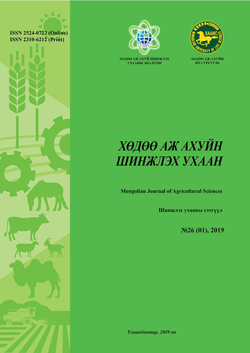Spatial distribution pattern of dryland plants: Turing pattern in water limited conditions
DOI:
https://doi.org/10.5564/mjas.v28i03.1300Keywords:
Spread of plants in the govi desert method of spectral un-mixing, regionAbstract
The plants in the Gobi desert region are sparsely distributed on a vast bare field, it is extremely difficult to accurately observe from the satellite. For the reason, the reflectance of dry soil is very high and the reflectance of slightly distributed plants is eliminated by soil reflection. As a result, the pixel’s NDVI value of desert plants shows a smaller value than the ground measurement. In this study, we succeeded to analyze Turing pattern of vegetation abundance using the method of spectral un-mixing for satellite data of the Gobi plants. It is shown that the fraction of the vegetation endmember after pixel un-mixing has a remarkably high correlation (R2=0.51 in Landsat 8 and R2=0.41 in Sentinel 2) with the ground true value of vegetation coverage.
Гандуу бүсийн ургамлын орон зайн тархалт: тюрингийн хэлбэршил ус гачиг нөхцөлд илрэх нь
Говь цөлийн ургамалшил нь асар уудамгазар дээр алаг цоог мөртлөө тачир сийрэг тархдаг тул хиймэл дагуулаас нарийвчлан ажиглахад хэцүү байдаг. Гол шалтгаан ньзайнаас тандсанцацраг туяа нь хуурай нүцгэн хөрсний маш өндөр ойлтын нөлөөгөөртачир сийрэг ургамлын цацрагийн ойлт сул, шингээлт нь дарагдаж илэрдэггүй байдал юм. Үүний үр дүнд цөлийн ургамлын хйимэл дагуулын зураг дээрх утга нь газрын гадаргуу дээр шууд хийсэн хэмжилтээс бага утгыг харуулж байдаг. Энэхүү судалгаанд бид хиймэл дагуулын мэдээг спектр үл холих аргыг ашиглан боловсруулжговийн ургамалшил Тюрингийн хэлбэршлийн дагуу тархаж байгаа зүйтогтлыг батлав. Спектр үл холих аргаар тогтоосон ургамлан бүрхэвчийн зайнаас тандсан мэдээ нь газрын бодит хэмжилтийн утгатай харьцангуй сайн хамааралтай (Ландсат 8-д R2 = 0.51, Сентинел 2-т R2 = 0.41) байна.
Түлхүүр үг: Спектр үл холих арга,Говь цөлийн ургамлын тархац
Downloads
524
Downloads
Published
How to Cite
Issue
Section
License
Copyright on any research article in the Mongolian Journal of Agricultural Sciences is retained by the author(s).
The authors grant the Mongolian Journal of Agricultural Sciences a license to publish the article and identify itself as the original publisher.

Articles in the Mongolian Journal of Agricultural Sciences are Open Access articles published under a Creative Commons Attribution 4.0 International License CC BY.
This license permits use, distribution and reproduction in any medium, provided the original work is properly cited.




